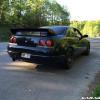Grex sandwichplate flow direction?
Announcements
-
Similar Content
-
Latest Posts
-
In all the track days I've done over the past few months I've only had 1 issue with braking and thats with my current EBC pads (can't remember the colour, but they're not a track pad). I don't *think* I have had issues with brake fluid getting too hot, my understanding is that when that happens you will have quite noticeable brake loss - which I haven't had. I'm using just regular ol' Penrite Super DOT4 fluid. I use this fluid in everything and my cars always seem to stop so I see no reason to change, except ... for the 335i. I need to do a fluid flush and was thinking about my fluid of choice and wondering if I should consider using something more high temp? Its not a super fast car by any standards but I'd hate to do a flush and then find myself with no brakes when I get. to Wakefield. I guess, my question can be summed up as "How fast do you need to be driving to need higher temp brake fluid?" I remember high temp fluid was considered a must have back in the day when I had my GTR.
-
By Jason Abell · Posted
For anyone that comes here looking for answers on what can go wrong with gts-4 to rb25detneo swap. The Gloria's awd sump is different and does not fit. The rb25neo from stagea are exactly the same sump bolt pattern and axel alignment. Castings numbers are different on Gloria's blocks and oilpans if they need to be identified. -
By Jason Abell · Posted
I have information on this for anyone that comes looking again. https://www.facebook.com/share/p/18gsbFaYTU/ The rb25det neo from the stagea has the same sumo as rb26 and r32 gts4 (and other awd models). The sump that has caused so many problems during swaps are from the awd neo Gloria's. The casting numbers on the block and oil pans are different so this may help identify if you can't confirm where the motor came from
-









Recommended Posts
Create an account or sign in to comment
You need to be a member in order to leave a comment
Create an account
Sign up for a new account in our community. It's easy!
Register a new accountSign in
Already have an account? Sign in here.
Sign In Now